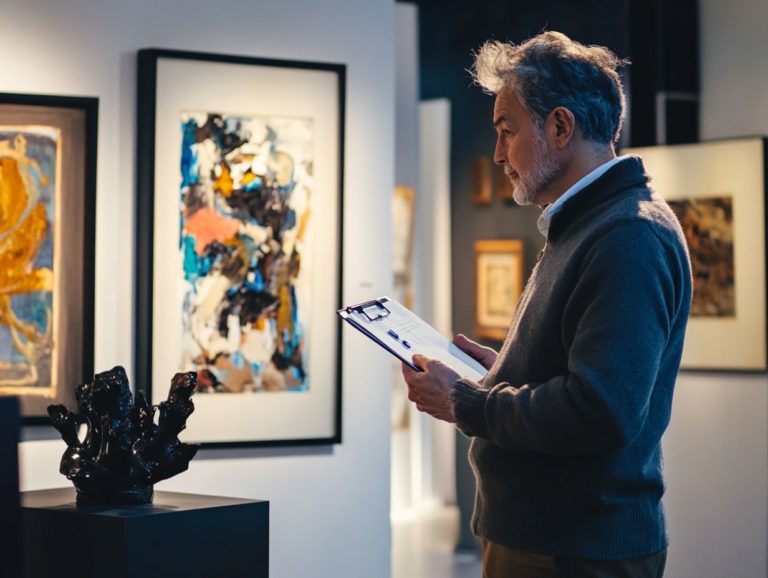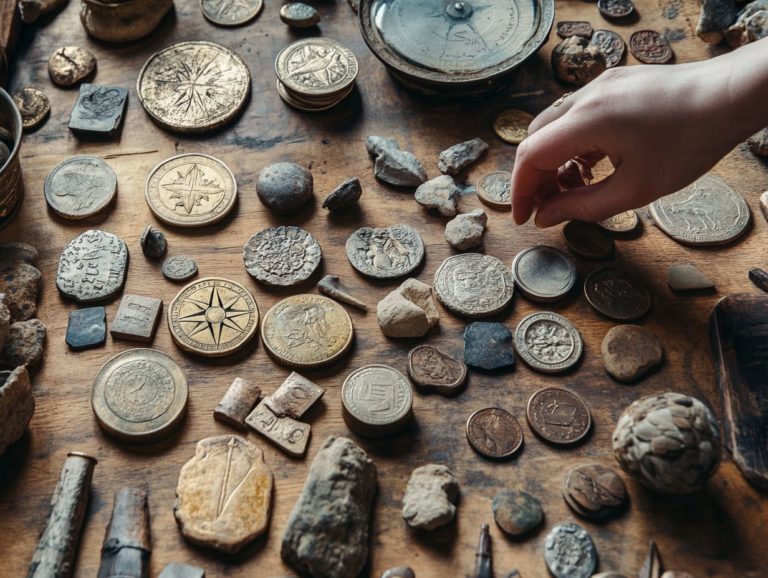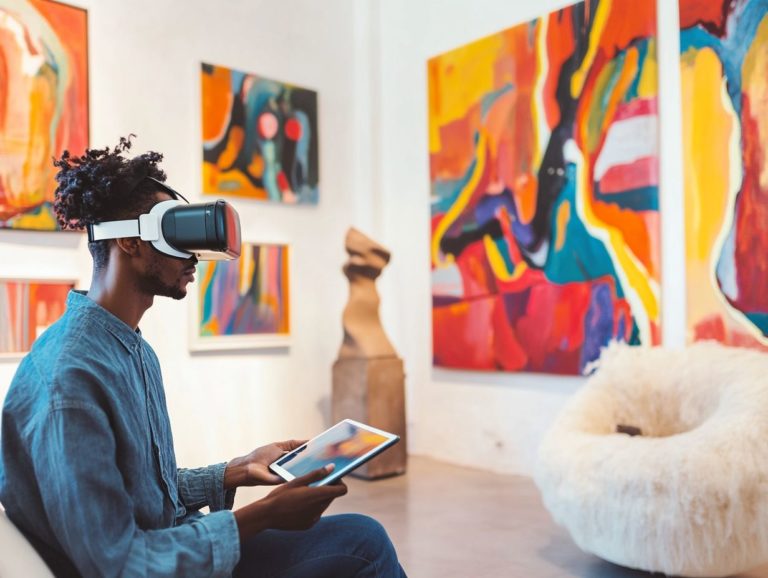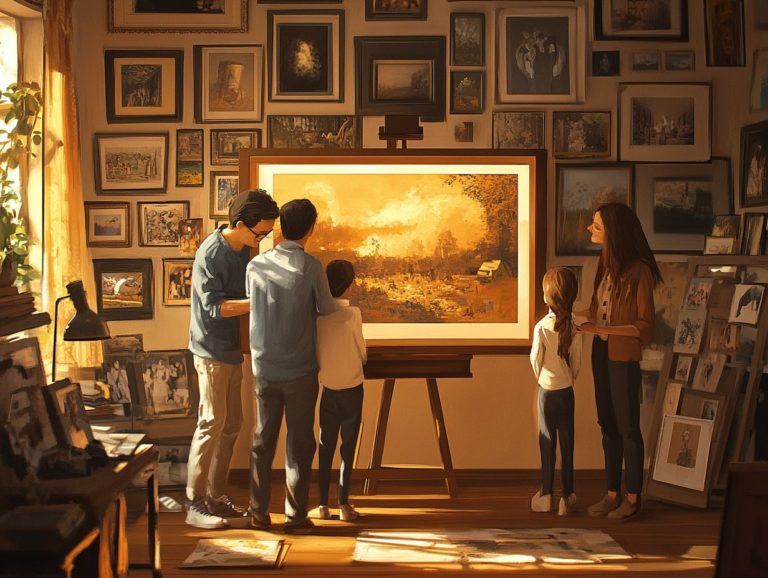Understanding Art Market Trends for Collectors
Navigating the art market can feel like an exhilarating adventure, but it can also be overwhelming, especially when you’re eager to make informed investments.
This article distills the essentials of art market trends, starting with a clear definition and exploring the various factors that shape them, from economic shifts to cultural movements. You’ll discover practical tools for identifying and analyzing these trends, along with a discussion on their implications for collectors.
Expect expert insights on predicting future movements in the art world as well.
Whether you re a seasoned collector or just starting out in this vibrant realm, this guide will arm you with the knowledge you need to confidently navigate the ever-evolving art landscape.
Contents
- Key Takeaways:
- The Basics of Art Market Trends
- Factors Influencing Art Market Trends
- Identifying and Analyzing Art Market Trends
- Implications for Art Collectors
- Predicting Future Art Market Trends
- Frequently Asked Questions
- What are art market trends and why do they matter for collectors?
- How can I stay informed about current art market trends?
- What factors influence art market trends?
- Do art market trends follow a predictable pattern?
- How can I use art market trends to make informed decisions about buying and selling art?
- What should I be cautious of when considering art market trends?
Key Takeaways:
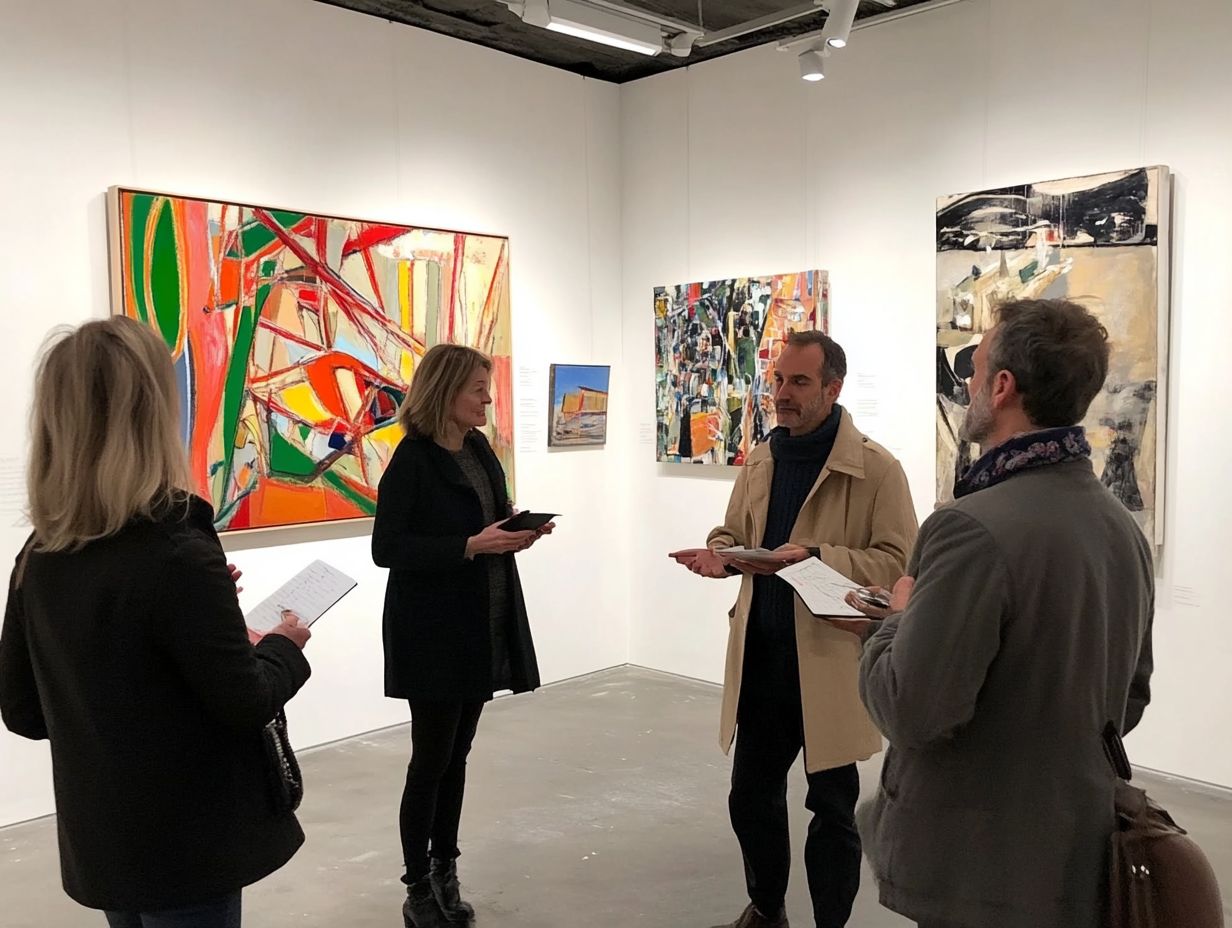
Keep up with the latest economic, social, and cultural factors that influence art market trends to make informed decisions as a collector. Utilize tools and strategies, like market reports and expert insights, to track and analyze art market trends and stay ahead in the collecting game.
Understanding art market trends can help you predict future movements and make smart investments in the evolving art market landscape. For insights on what makes art collectible, consider exploring key factors that influence value.
The Basics of Art Market Trends
Grasping the fundamentals of art market trends is crucial for anyone engaged in the art world, whether you re an art collector, dealer, or simply an enthusiast.
The art market is split into the primary and secondary segments, each with unique dynamics shaped by a range of economic factors and market movements.
Digital art and NFTs have changed traditional perspectives, opening up exciting opportunities for both emerging talents and established artists.
By diving into these trends, you can make informed decisions that elevate your experience and investment within the art community.
Defining Art Market Trends
Art market trends encompass the patterns and shifts observed in the buying and selling dynamics of art pieces. These trends are influenced by various factors, such as pricing strategies, artist visibility, and the role art institutions play in promoting different genres and styles.
To identify these trends, analyze auction results, gallery sales, and exhibition reviews. This analysis provides valuable insights into which types of work are gaining popularity.
For example, in recent years, the rise of digital art and NFTs has transformed market perceptions, bringing previously underrepresented artists into the spotlight.
Renowned institutions like the Tate Modern and MoMA have played a crucial role in this shift by showcasing contemporary artists who challenge traditional norms, reshaping the art landscape.
Moreover, pricing strategies like tiered pricing or limited-edition releases significantly influence collectors’ decisions and elevate the profiles of emerging talents, driving the market’s evolution.
Factors Influencing Art Market Trends
Art market trends are shaped by economic conditions, social and cultural dynamics, and the growing emphasis on diversity in art.
These elements collectively influence the art world s landscape and enhance the visibility of emerging talent.
Economic Factors

Economic factors shape the art market, influencing everything from the pricing strategies used by dealers to commission rates set by auction houses. This landscape guides your decisions as a collector or enthusiast, steering you toward responsible purchasing.
As inflation rates climb, the cost of materials for creating art can rise, resulting in higher prices for both emerging and established artists. Fluctuations in consumer spending directly impact the demand for artwork.
When you feel financially secure, you re more inclined to invest in art, while economic uncertainty often encourages a cautious approach.
The rise of online platforms has transformed market accessibility, allowing you to engage with art purchasing in ways previously unimaginable. This democratization impacts pricing strategies, making high-quality art more accessible, and encourages you to cultivate informed buying practices to navigate the complexities of the market successfully.
Social and Cultural Factors
Social and cultural factors significantly influence art market trends. They determine which artists capture attention and gain acceptance. This, in turn, affects the types of artworks that are collected and celebrated, especially through the efforts of art institutions dedicated to promoting diversity and emerging talent.
These institutions are pivotal, creating platforms that elevate underrepresented voices. They ensure a wider range of artistic expression is recognized and appreciated. This shift diversifies stories in the art world. It also changes what collectors prefer.
As new talent rises from diverse backgrounds, the art market embraces a more inclusive approach. It champions cultural movements that resonate with contemporary social issues. This cultivation of creativity weaves a rich tapestry that will shape future trends in collecting.
Identifying and Analyzing Art Market Trends
To spot art market trends, use a mix of tools and strategies that show what’s happening in the market.
This approach helps you, as an art collector or investor, grasp the visibility of artists and the changing preferences within the art market.
By leveraging these insights, you can navigate your decisions confidently and precisely.
Tools and Strategies for Tracking Trends
To effectively track art market trends, harness a variety of tools, such as market reports and analytics platforms like Artprice and Artsy. These resources provide essential data on pricing, sales, and emerging artists, giving you a comprehensive view of the market landscape.
These platforms feature in-depth analyses and user-friendly dashboards for both novice and seasoned collectors. For example, track individual artist performance and compare it against industry standards. This helps uncover hidden opportunities.
Tools like ArtRank provide insights into market sentiment by analyzing social media mentions and online activity. This offers a more holistic view of an artist’s visibility.
By using these resources, you can develop informed pricing strategies and make timely decisions based on market shifts. This ultimately enhances your collecting experience and boosts your investment potential.
Implications for Art Collectors

Understanding the implications of art market trends is essential for you as an art collector. These trends directly shape your collecting strategies, investment decisions, and commitment to responsible buying, as highlighted in Understanding the Art Market: A Collector’s Guide.
As diversity in art and the visibility of various artists gain significance, staying informed enables you to make thoughtful and impactful choices in your collection.
How Trends Affect Collecting and Investing
Trends in the art market play a pivotal role in shaping your approach to collecting and investing. Understanding key factors in the art market can help you navigate how economic factors and market dynamics significantly influence the value of artworks. They guide your strategic considerations for responsible buying.
In this ever-evolving landscape, it’s essential for you to remain vigilant and informed. Various economic influences like inflation, shifts in disposable income, and global events can impact demand.
For example, during economic downturns, emerging artists might be more appealing. Their works tend to be more accessible, while the prices of established names may fluctuate.
To navigate these changes, savvy collectors like you often diversify portfolios by genre or medium. They also consider pieces that align with anticipated future trends, such as sustainable or digital art.
Engaging with market analyses and attending art fairs can offer valuable insights. This ensures you make educated decisions as you pursue both personal enjoyment and potential returns.
Predicting Future Art Market Trends
Predicting future art market trends demands a mix of expert insights and advanced forecasting techniques.
You need to analyze current market indicators, consider the growing influence of digital art and NFTs, and recognize the emergence of new artistic talents.
These elements collectively shape the ever-evolving landscape of the art world, allowing you to stay ahead of the curve.
Dive in and discover the exciting world of art collecting today!
Expert Insights and Forecasting Techniques
Expert insights into art market trends use various forecasting techniques. These methods analyze historical data, current economic factors, and the critical role of art institutions.
Art institutions, including galleries and auction houses, are essential in this landscape. They curate collections and provide valuable sales data that informs predictions.
Understanding economic indicators like consumer spending can help you navigate the art market. This approach equips you with the tools needed to make informed decisions in the evolving art world.
Frequently Asked Questions
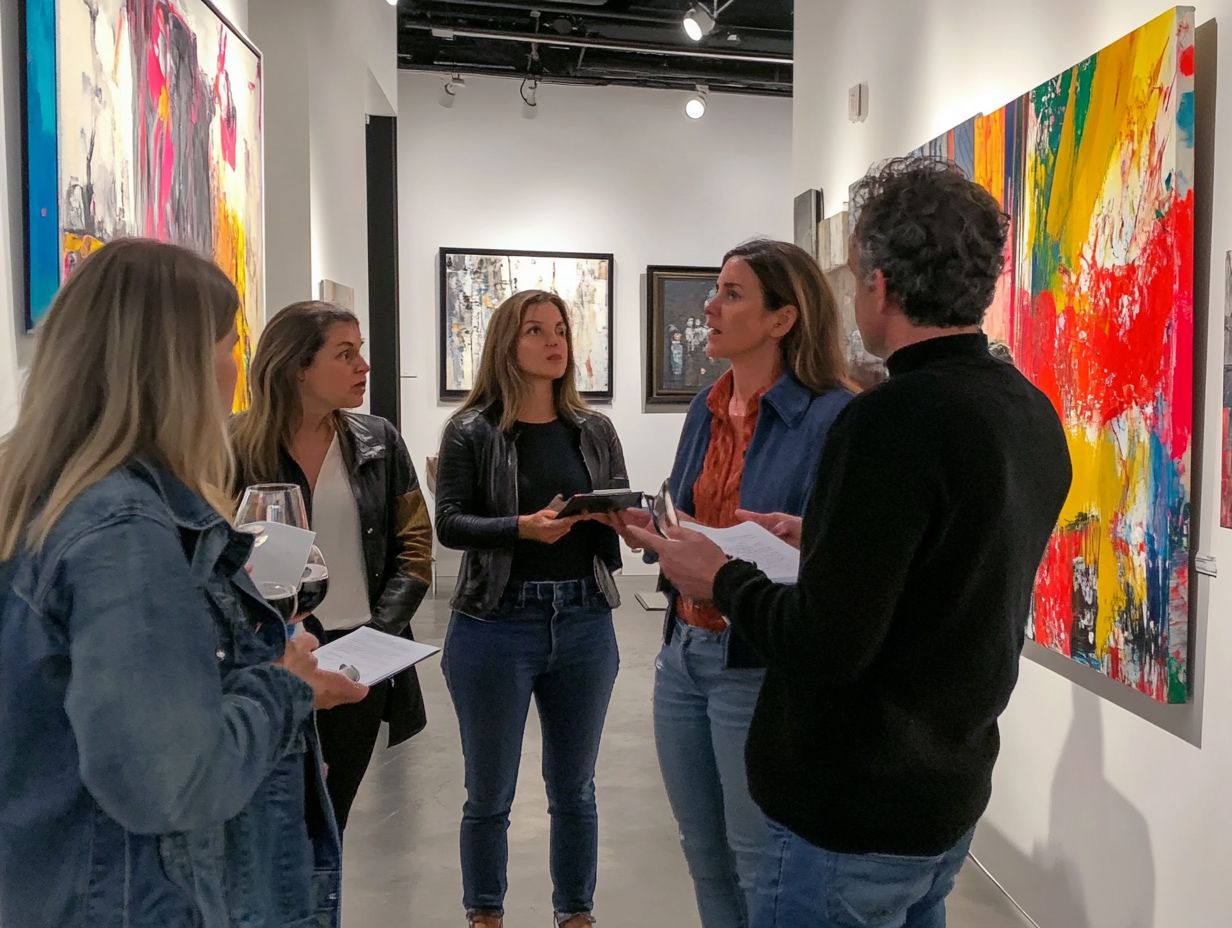
What are art market trends and why do they matter for collectors?
Art market trends refer to the patterns in buying and selling art, including which artists are in demand. They are crucial for collectors as they impact the value and resale potential of collections.
How can I stay informed about current art market trends?
Stay informed by reading reports from reputable sources, attending art fairs, and networking with professionals. Engaging with the community helps you stay ahead.
What factors influence art market trends?
Art market trends can be influenced by economic conditions, popular culture, and preferences of influential collectors. These factors shape the art landscape.
Do art market trends follow a predictable pattern?
While some cycles exist, trends are often unpredictable. Unexpected events can change the trajectory of the market.
How can I use art market trends to make informed decisions about buying and selling art?
By staying updated on trends, you can make strategic choices about investments. Consider potential future value and demand.
What should I be cautious of when considering art market trends?
Art market trends can change quickly, so it’s essential to verify the credibility of your sources. Avoid relying on unverified information.
For more insights and updates, consider subscribing to our newsletter for the latest trends in the art market!

